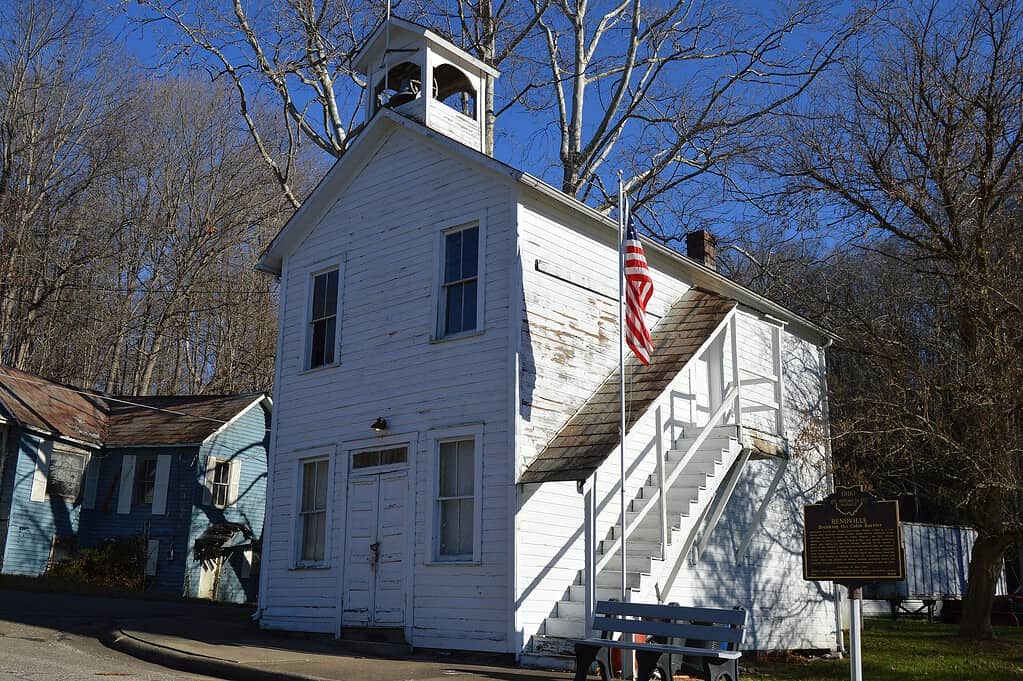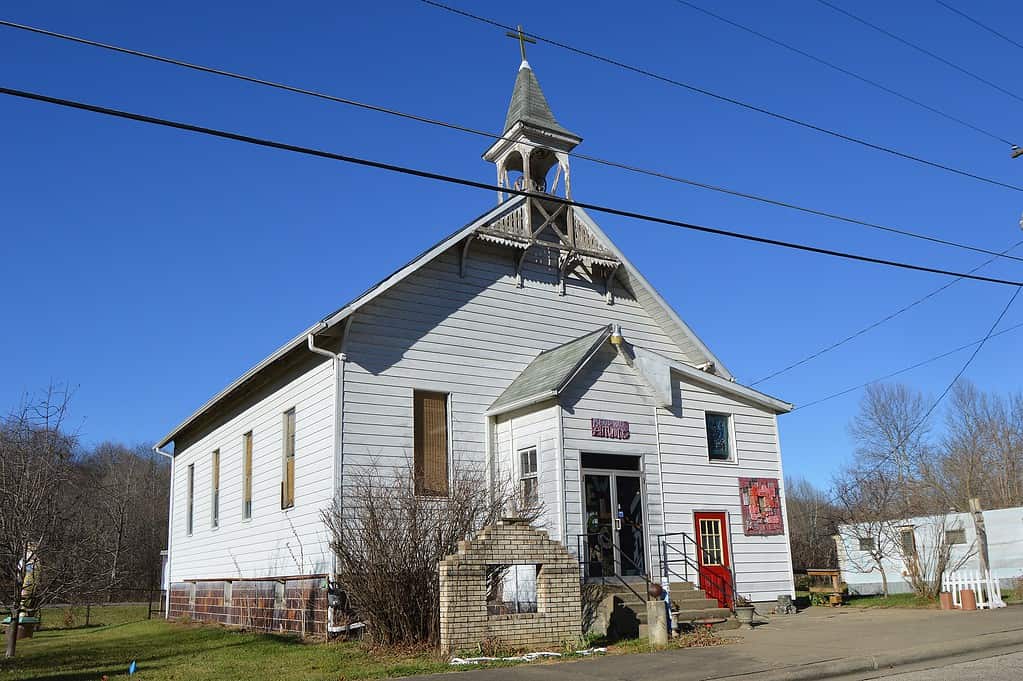Columbus is Ohio’s capital and the largest city in the state. With a population of 907,971 (2022 U.S. Census Bureau estimate), it is the fourteenth largest city in the United States. The Greater Columbus metro area is home to 2.1 million people and will possibly swell to 3.15 million by 2050. But what about the opposite end of the spectrum? What community holds the title of Ohio’s smallest town? The answer is much more than simple, obscure trivia. This town’s story is filled with historical firsts, and its legacy is one that we cannot afford to forget.
Rendville, Ohio
The smallest town in Ohio is Rendville.
Rendville is located in Perry County in east-central Ohio. It sits about 25 miles north of Athens.

Ohio’s smallest town is located in Perry County in the east-central part of the state.
©David Benbennick / Public domain – License
The town’s footprint is less than ⅓ of a square mile. The 2020 census reported a grand total of 28 residents in Rendville, making it the smallest incorporated community in the state.
For a bit of added perspective, the average small coffee shop in the United States has a seating capacity of 30-40 people. All of Rendville’s residents could easily meet for coffee inside one of these shops.
The town wasn’t always so tiny, though. Rendville’s highest census count was in 1890, when 859 people made their homes in the town. Unofficial records show that the population may have been even higher than that, possibly upwards of 1,000 at its peak.
Today, Rendville is a shell of what it once was. This makes it all too easy to overlook the history that was made in this Ohio town. However, the legacy of Rendville is one that we forget at our own peril.

The town hall sits quietly on the only street in the one-block-long Ohio village of Rendville.
©Nyttend / Public domain – License
The Founding of Rendville
William P. Rend founded the town in 1879. He was born in County Leitrim, Ireland, in 1840 and immigrated to the U.S. with his parents when he was seven years old. He became a teacher in Massachusetts before enlisting in the Fourteenth New York Volunteers at the onset of the Civil War.
After the war, Rend moved to Chicago, where he became a successful industrialist. Rend expanded his business interests to include mining and shipping coal. He opened a coal mine near the Ohio town that would bear his name. He built Rendville as a home for the miners in his employ. Since mines were often located in remote areas, it was common practice for mining companies to build towns near the mines for their workers.
Ohio’s First Integrated Village
As an immigrant himself, Rend was sympathetic to the plight of immigrants who struggled to find work. He brought Irish, Scottish, Hungarian, Welsh, and other immigrants to Rendville to work in his mine. Many of these workers spoke little to no English.
Along with these immigrant workers, Rend also brought African American workers to Rendville, mostly from West Virginia. Rendville became the first integrated village in Ohio, with multiple ethnicities and nationalities represented. Rendville was the Ohio town that broke the color barrier, as you can read on one of the historical markers that stand next to Rendville’s town hall today.
This kind of “melting pot” was highly unusual and quite controversial at the time. Chattel slavery had been legal in the American South for generations. The Civil War, which finally ended the scourge of legal slavery in the United States, concluded a mere fourteen years before the foundation of Rendville. Many of the African American miners in Rendville were former slaves or children of slaves.
The Corning War
The influx of these black miners in Rendville infuriated the white miners in the nearby town of Corning. They were afraid the African American miners would be willing to work for less money and would drive down their own pay as a result. They overlooked that Rend offered his miners equal pay, regardless of their race (another practice virtually unheard of in the late nineteenth century).
Fear and anger boiled over, and the white miners from Corning organized an armed mob to drive the black miners out of Rendville. Governor Charles Foster deployed the Ohio National Guard to diffuse the situation. No lives were lost, but a few of the Corning miners were injured in a small clash with Ohio troops. The event came to be known as The Corning War.
A Lawless Town
Despite the ongoing threat from the Corning miners, Rendville grew into a coal mining boom town. While the town was turning a significant profit for the Ohio Central Coal Company, it was a difficult place to live. Most of the town’s residents were young men who worked in the mine. The town’s burgeoning economy gave rise to every conceivable pleasure and vice. Gambling was a favorite pastime. Allegedly, there was one bar for every 25 residents in Rendville. The town devolved into a violent and lawless place at the same time that it reached its economic peak. However, harsh changes were coming.
As coal flooded the market, coal prices plummeted. By the mid-1890s, many miners were unemployed and deep in debt. That, coupled with a devastating fire in Rendville in 1901, sent the town on a downward trajectory from which it would never recover. The Great Depression of the 1930s only hastened the town’s decline.
Rendville’s Spiritual Awakening
After the lawless days of the coal boom, Rendville had a spiritual awakening. As the bars closed, churches opened their doors 24 hours a day, seven days a week, to welcome citizens who came to reflect, pray, and try to make sense of the upheaval thrust upon them as the coal market dried up.
One such citizen was Adam Clayton Powell, Sr. He had been one of the town’s notorious hard-living young men, but Powell experienced a religious conversion at a revival hosted by First Baptist Church in Rendville. The church has since disbanded. The building now houses the Rendville Art Works, where developmentally disabled people gather to paint and create other pieces of art.

The old First Baptist Church building now houses Rendville Artworks.
©Nyttend / Public domain – License
After his conversion in Rendville, Powell entered the ministry. He went on to become the pastor of the world-famous Abyssinian Baptist Church in Harlem, New York, and one of the most influential civil rights leaders of his day.
Historic Firsts
Not only was Rendville the first integrated community in Ohio, but it was also the site of several other historic firsts.
Dr. Isaiah Tuppins
Dr. Isaiah Tuppins moved to Rendville in 1884. He had been a barber as he worked his way through medical school. Tuppins was the first African American to receive a medical degree in Ohio when he graduated from Columbus Medical College, which would later become The Ohio State University College of Medicine. Dr. Tuppins came to Rendville to serve as the town’s physician. However, he would make history again in 1888 when he was elected mayor of Rendville, making him the first African American mayor in Ohio.
Richard L. Davis
Richard L. Davis was born into slavery in Virginia in 1862. He moved to Rendville in 1882 where he worked as a checkweighman. Miners were paid according to the amount of coal they mined. A checkweighman was chosen to represent the miners by ensuring the mining company weighed the coal accurately and compensated the miners fairly.
This would only be the beginning of Davis’ fight for miners’ rights, though. He went on to help found the United Mine Workers Union and fought continuously for racial and salary equality in the mining industry. Today, there is a historical marker in Rendville honoring Davis. His powerful vision for racial harmony and equality is permanently etched on the marker: “I say, white brother, because I believe that to be the proper phrase, inasmuch as I believe in the principle of the fatherhood of God and the brotherhood of all mankind, no matter what the color of his skin may be.”
Roberta Preston
The Rendville post office opened in 1879 and remained for over a century. It was shuttered in 1982. This small town post office was the site of another historic first. Roberta Preston was named the postmaster of Rendville in 1963, making her the first African American woman to be a postmaster in Ohio.
Sophia Mitchell
Six years later, Sophia Mitchell was appointed mayor of Rendville, becoming the first black woman to serve as a mayor of a municipality, not just in Ohio, but in the United States as a whole. Mitchell served multiple terms, but she noted that she never ran for office. Instead, she was appointed to the post. The first African American woman to win a mayoral election was Lelia Foley, who was elected mayor of Taft, Oklahoma, in 1973.
Preserving Rendville’s Legacy
According to the U.S. Census Bureau, there were 790 residents in Rendville at the turn of the twentieth century. At the dawn of the twenty-first century, the number had dropped to 46. Today, it stands at 28. However, the tiny remnants of this town belie the pivotal role it played in Ohio’s history and the history of the United States as a whole.
Jerry Jackson is committed to preserving the history of his hometown. Jackson moved to Rendville as a young boy and recalls growing up in this small town in the mid-1900s. He notes that people of different races lived and worked together in harmony and peace.
Jackson lived in Rendville until he went to college. He became a standout basketball star at Ohio University and was drafted by the Detroit Pistons in 1964. He is a member of the Ohio University Basketball Hall of Fame.
Jackson helped form the Rendville Historical Preservation Society in 2015. As the population of this tiny Ohio town continues to dwindle, Jackson and others in this society are working to ensure the history and legacy of Rendville live on.
Jackson shared his thoughts on growing up in Rendville in the video interview below.
Rendville Today
Not much remains of this historic coal town. Downtown Rendville extends for just one block. A handful of small clapboard houses line the street, along with the town hall (or the Mayor’s Office, as it is known to the residents), Rendville Art Works, and some abandoned, deteriorating buildings are about all that is left in Rendville. An abandoned schoolhouse is also concealed from view in the nearby woods.
Most drivers that pass through the area on Ohio Route 13 don’t even know Rendville is there. They just whiz right on by, completely oblivious to the history that was made in Ohio’s smallest town. However, if you are ever in Perry County, don’t rush on to your destination. Make a point to stop in Rendville and remember the legacy of this tiny town.
But even if we never venture there in person, we can all reflect on Rendville’s history and use it as we move forward in our own lives. This town that broke the color barrier in Ohio reminds us of what is possible when we see the simple and beautiful humanity in one another. Or, as Richard L. Davis said, we can remember “the brotherhood of all mankind, no matter what the color of his skin may be.”
The photo featured at the top of this post is © Nyttend / Public domain – License / Original
Thank you for reading! Have some feedback for us? Contact the AZ Animals editorial team.






